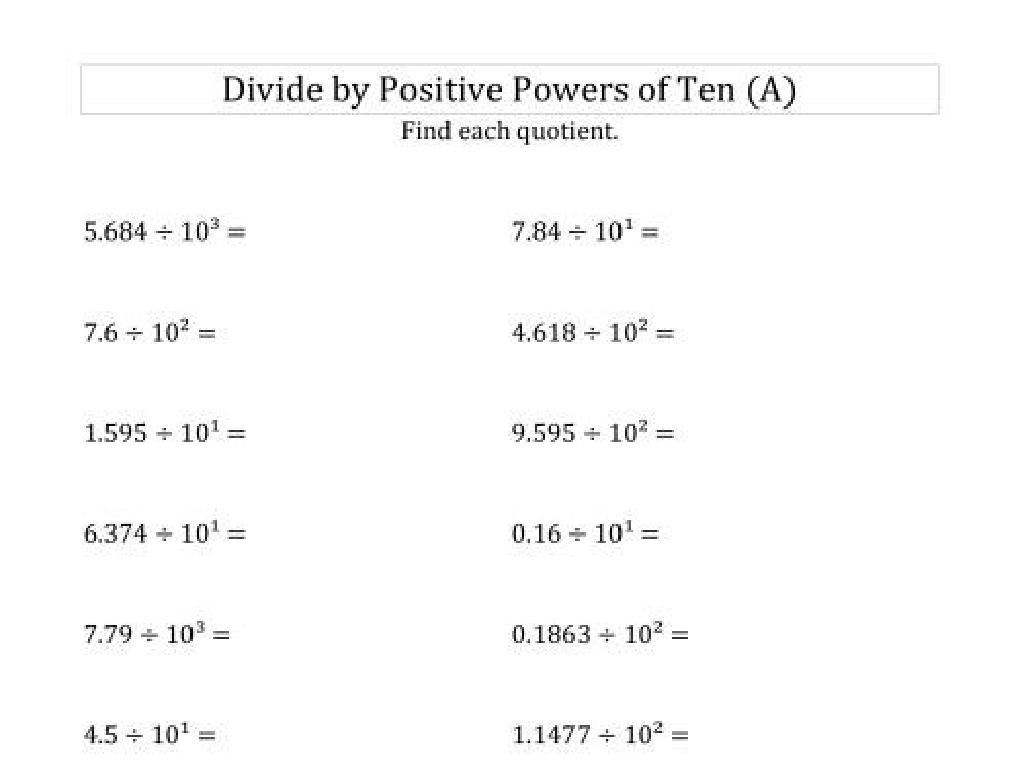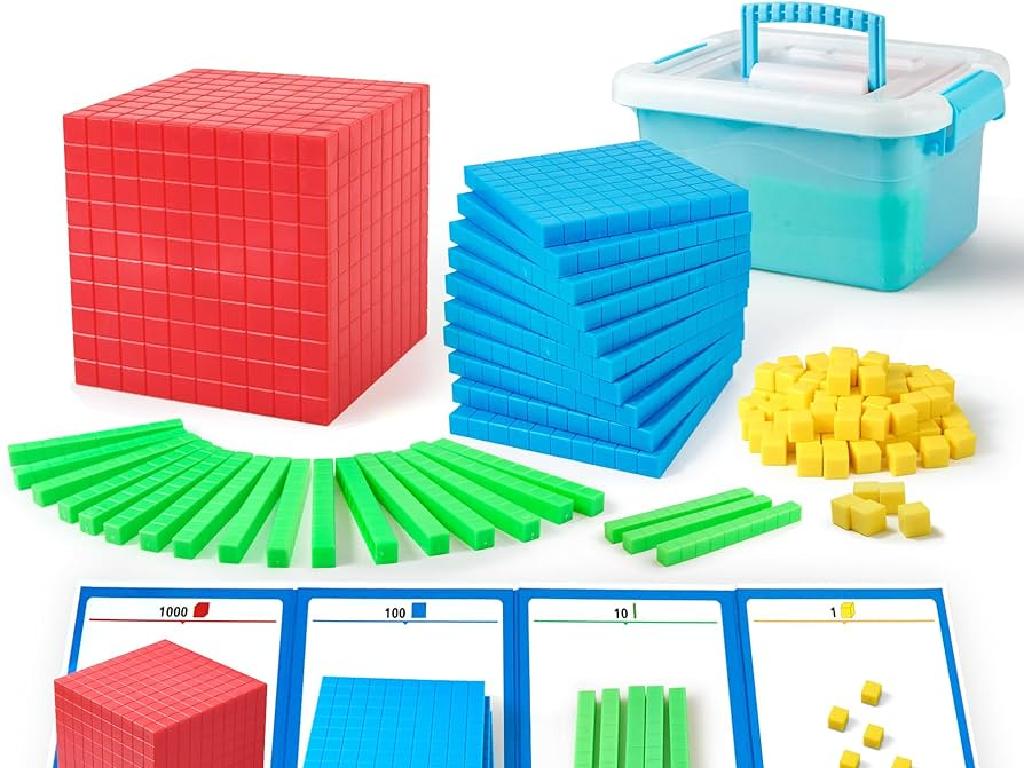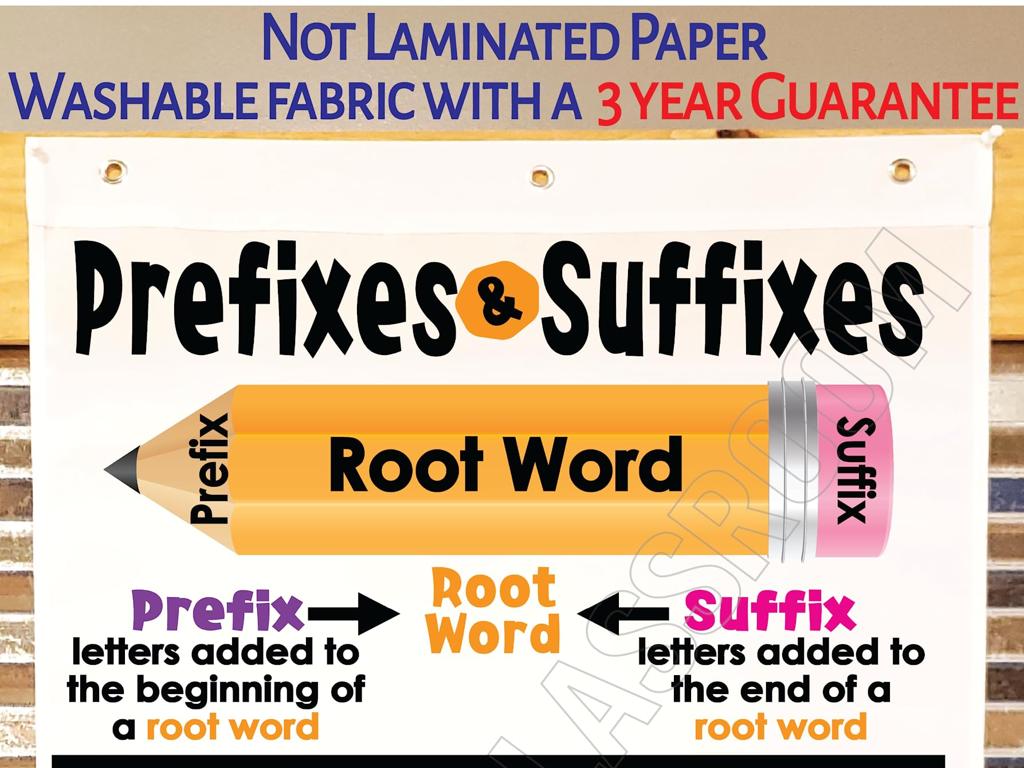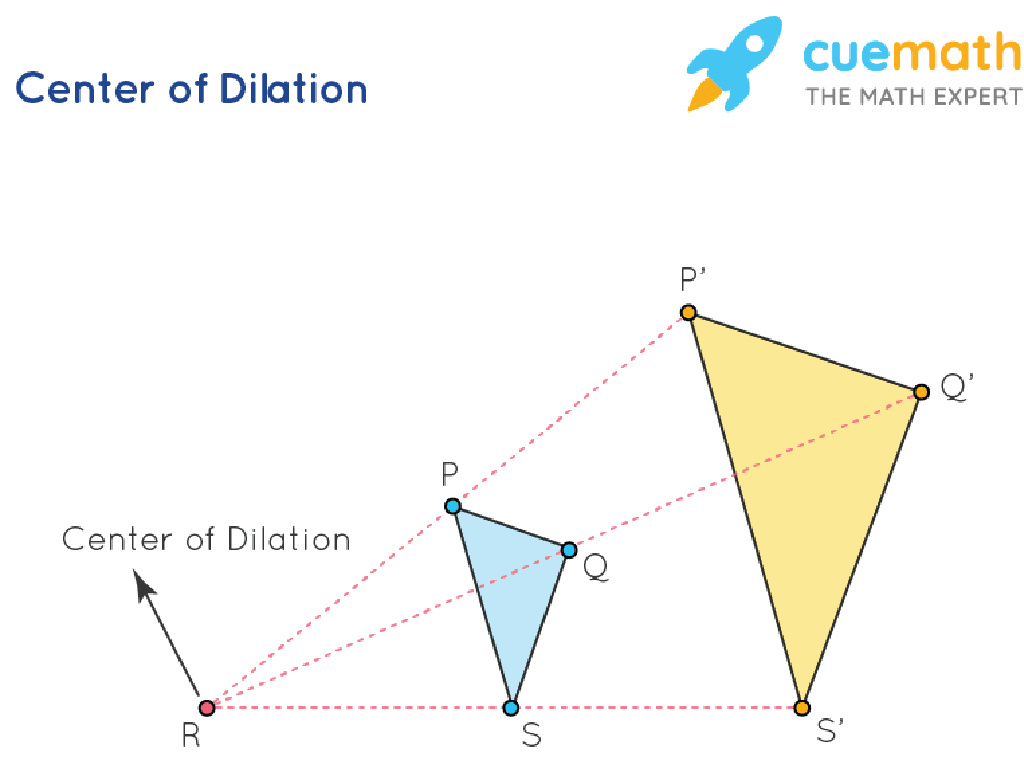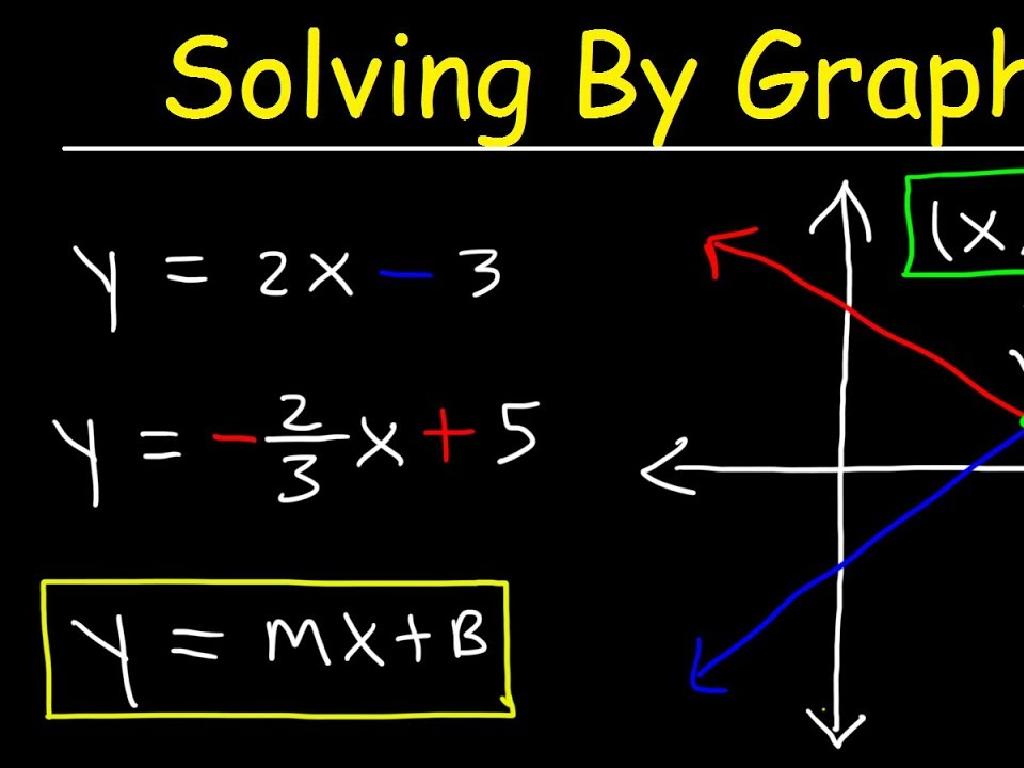Write Numbers As Tens And Ones Up To 20
Subject: Math
Grade: First grade
Topic: Place Value
Please LOG IN to download the presentation. Access is available to registered users only.
View More Content
Welcome to Place Value!
– Greeting First Graders!
– Today’s topic: Place Value
– Understanding Tens and Ones
– Tens are groups of 10, Ones are single units
– Counting with Tens and Ones
– Example: 15 is 1 Ten and 5 Ones
|
This slide introduces the concept of place value to first graders, a fundamental part of understanding numbers. Begin by greeting the students warmly to create an inviting learning environment. Explain that place value helps us see numbers as tens and ones, which is how we break down and understand larger numbers. Use visual aids like blocks or drawings to show groups of ten and single ones. For instance, show 10 blocks grouped together to represent a ‘ten’ and individual blocks to represent ‘ones’. This visual representation will help students grasp the concept of counting in tens and ones, setting the groundwork for addition and subtraction within 20. Encourage the students to practice with numbers up to 20 by breaking them down into tens and ones, and prepare manipulatives for hands-on learning.
Understanding Place Value
– What is place value?
– Place value shows the value of each digit in a number.
– Value of numbers in places
– A digit can mean different things depending on where it is.
– ‘Ones’ and ‘Tens’ places
– The rightmost place is ‘ones’, next to the left is ‘tens’.
– Counting with tens and ones
– Practice counting objects by grouping into tens and ones.
|
This slide introduces the concept of place value, which is fundamental in understanding how numbers are built and how to count beyond 10. Start by explaining that each digit in a number has a different value depending on its position. Use simple examples like 15, where there is 1 ten (10) and 5 ones (5), to illustrate the concept. Use visuals like blocks or drawings to show groups of ten and individual ones. Encourage students to practice by grouping items into tens and ones to reinforce the concept. This will set the foundation for addition and subtraction within 20.
Counting with Ones: Learning Place Value
– Count objects one by one
– Each object equals one unit
– A single apple, block, or pencil can represent one unit
– Practice counting 1 to 10
– Use items like toys or fingers to count up to ten
– Understand ones in numbers
– Recognizing that the ‘ones’ place is the key to counting
|
This slide is aimed at helping first graders understand the concept of counting with ones and place value. Start by demonstrating how to count objects one by one, emphasizing that each object represents a single unit. Use tangible items such as blocks or toys to make the counting process interactive. Practice counting together from 1 to 10, and ensure that students can recognize the numbers and associate them with the quantity of objects. Reinforce the idea that the ‘ones’ place in a number tells us how many individual units there are. For the activity, students can bring their favorite small items from home to count in class, or you can provide classroom objects for this purpose. Encourage students to count aloud and use their fingers if necessary to represent each number as they count.
Making Groups of Ten
– Understanding ‘tens’ and ‘ones’
– A ‘ten’ is made of 10 ‘ones’.
– Grouping objects into tens
– Put 10 things together to make a ‘ten’.
– Counting tens in groups
– See how many groups of ten you can make.
– Practice with real items
– Let’s use items like pencils or blocks to learn!
|
This slide is aimed at helping first graders understand the concept of tens and ones, which is fundamental in learning place value. Start by explaining that a ‘ten’ is simply a group of 10 ‘ones’. Use physical objects like blocks or pencils to visually demonstrate grouping items into tens. Have the students practice making groups of ten and then counting how many groups they have. This hands-on activity will help solidify their understanding of how numbers are composed of tens and ones. Encourage the students to bring items from home that they can group into tens for the next class to make the learning process more engaging and relatable.
Understanding Place Value: Tens and Ones
– Numbers made of tens and ones
– Example: 15 is 1 ten and 5 ones
– Like 10 is a bundle of 10 ones, 15 has 1 bundle plus 5 extra ones
– Practice with numbers up to 20
– We’ll write different numbers as groups of tens and ones
|
This slide introduces the concept of place value to first graders, focusing on the composition of numbers up to 20 using tens and ones. Begin by explaining that every number is made up of tens and ones. Use physical objects like blocks or counters to visually demonstrate the concept, grouping them into sets of ten. For example, show 15 as a group of 10 (one ten) and 5 additional single units (ones). Encourage students to practice by breaking down numbers up to 20 into tens and ones, reinforcing the idea that the left digit represents tens and the right digit represents ones. This foundational understanding of place value is crucial for their future math skills development.
Understanding Place Value: Tens and Ones
– Exploring number 12
– Writing 12 with tens and ones
– Break down 12 into 10 and 2
– 12 equals 1 ten and 2 ones
– Visualize 12 as a group of 10 and 2 individual units
|
This slide is aimed at helping first graders understand the concept of place value for numbers up to 20. Start by focusing on the number 12 as an example. Explain that in the number 12, the ‘1’ represents one group of ten, and the ‘2’ represents two individual ones. Use visual aids like blocks or drawings to show one group of ten and two separate ones. This will help students visualize the concept of tens and ones. Encourage students to practice with other numbers and prepare manipulatives for hands-on learning. The goal is for students to be able to break down any number up to 20 into tens and ones independently.
Your Turn to Try: Writing Numbers as Tens and Ones
– Write numbers using tens and ones
– Group ones to make tens
If you have 10 ones, that’s the same as 1 ten!
– Practice with given numbers
Use the numbers 11, 14, 16, and 19 for practice.
– Remember to count carefully
|
This slide is an interactive activity for students to practice writing numbers as tens and ones. Start by reminding them that they can group sets of ten ones to make a ‘ten.’ Then, provide them with specific numbers (11, 14, 16, and 19) and ask them to break these numbers down into tens and ones. For example, 14 is 1 ten and 4 ones. Encourage students to use objects like blocks or counters to physically group ones into tens for a better understanding. This hands-on activity will help solidify their grasp of place value and the concept of tens and ones. As they work, walk around the classroom to offer guidance and ensure they are grouping correctly. After the activity, discuss as a class and correct any misunderstandings.
Class Activity: Building Numbers with Blocks
– Understand blocks represent units
– Build numbers using blocks
– Each small block is ‘one’ and a stick of 10 blocks is ‘ten’
– Use tens and ones blocks
– Combine tens and ones to make a number
– Create numbers up to 20
|
This activity is designed to help first graders visualize and understand the concept of place value. Provide students with physical blocks where each small block represents one unit and a stick of 10 blocks represents ‘ten’. Encourage them to create different numbers up to 20 using these tens and ones blocks. For example, to make the number 14, they would use one stick of 10 blocks (ten) and four single blocks (ones). This hands-on activity will help them grasp how numbers are composed of tens and ones. Possible variations of the activity could include: having students work in pairs to build numbers, challenging them to find multiple ways to create the same number, or asking them to represent numbers in a drawing after building them with blocks.
Review: Tens and Ones
– Recap on tens and ones
– We learned numbers are made up of tens and ones
– Writing 17 using tens and ones
– 17 is 1 ten and 7 ones
– Open floor for questions
– Class participation encouraged
– Share your understanding or ask for help!
|
This slide aims to consolidate the day’s learning about place value, specifically focusing on tens and ones. Start by asking the class to summarize what they’ve learned about breaking down numbers into tens and ones. Then, use the number 17 as an example to visually demonstrate how it can be separated into 1 ten (10) and 7 ones (7). Encourage students to participate by showing their own methods or understanding of the concept. Finally, open the floor for any questions to clarify doubts and ensure everyone is on the same page. This interactive review session will help reinforce the concept and assess the students’ grasp of the material.
Great Work on Place Value!
– Proud of your tens and ones learning
– Practice with parents at home
– Use toys or snacks to make groups of ten
– Bring tens and ones homework
– Show and tell tomorrow!
– Share what you’ve learned with the class
|
This slide serves as a conclusion to the lesson on place value, specifically focusing on writing numbers as tens and ones up to 20. It’s a reminder for students to reinforce what they’ve learned by practicing at home with their parents, using everyday items to create visual groups of ten. Encourage them to be creative with the items they use for counting. The homework will be due the next day, and students should be prepared to present their understanding of tens and ones in a show-and-tell format. This activity will help solidify their comprehension of the concept and allow them to demonstrate their knowledge in a fun and engaging way.

